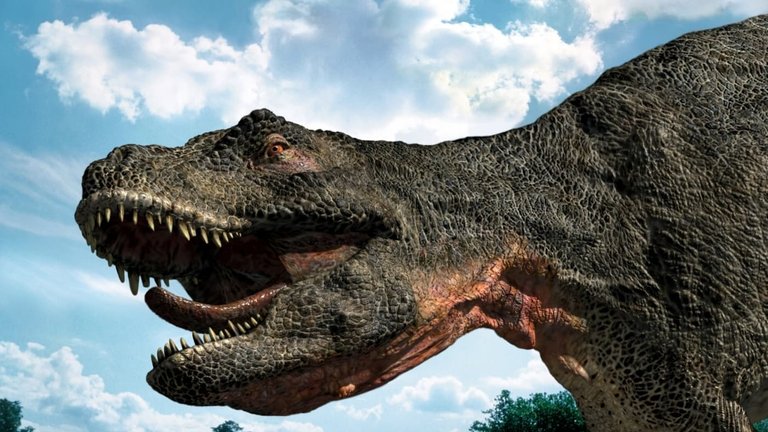Television Review: Walking with Dinosaurs (1999)

BBC was for the most of 20th Century synonymous with quality television, providing diverse content and setting standards almost all other public televisions in the world were trying to achieve. One of the most popular and the highest regarded content were wildlife documentaries. Probably the most spectacular, most influential and the most groundbreaking was Walking with Dinosaurs, 1999 six-part miniseries directed by Tim Haines and Jasper Jaines.
Walking with Dinosaurs isn’t the wildlife documentary in the traditional sense, because, as the title suggests, the wildlife being shown haven’t been around for a very long time. Instead, show’s creators had to rely on the palaeontological research and, sometimes, their own imagination to reconstruct dinosaurs, large group reptiles that dominated land fauna in the Mesosoic period of Earth’s history. The series is divided in six 30-minute episodes, each set in different time period. “New Blood”, the first episode, begins in today’s Arizona 220 millions years ago, during the late Triassic period, when therapsids, previously dominating reptile-like land animals are giving way to newly evolved form of reptiles known as dinosaurs, represented by relatively small, but highly adaptive predator known as coelophysis that would force cynodonts, ancestors of today’s mammals, to seek shelter underground. Second episode “Time of the Titans” is set in Colorado 152 million years ago, during Jurassic period, and follows life of female diplodocus from being hatched in large conifer forest to growing up into the largest animal to walk the planet. Third episode “Cruel Sea” is set on the coast of Oxfordshire 149 million years ago and displays marine reptiles that thrive in shallow seas, ranging from fish-like Ophtalmosaurus to monstrous shark-eating Liupleurodon. Fourth episode “Giant of the Skies”, set in today’s Brazil, North America and Europe 127 million years ago, during early Cretacious period, shows the last journey of giant flying reptile ornticheirus. Fifth episode “Spirits of the Ice Forests” is set in Anctarctica 106 million years ago, and shows how the small clan leaellynasaurs adapted to harsh conditions around South Pole. The series ends with “Death of the Dynasty”, set 65 million years ago in Montana, which shows iconic tyrannosaurus rex among the dinosaurs that would be wiped by cataclysmic meteor strike.
Tim Haines, series creator, got the idea of showing dinosaurs in the form of traditional wildlife documentary after the success of Spielberg’s Jurassic Park, blockbuster that had shown that the modern computer graphics can reconstruct ancient giant animals with level of detail and effectiveness inconceivable in previous decades. CGI played important part in production, but the animals were also reconstructed with the help of old school special effects like animatronics and miniatures, with some of real life but exotic-looking locations in Tasmania, Chile, New Zealand, New Caledonia, California and Bahamas standing for prehistoric Earth. Some of the effects might look slightly dated quarter of century, but they are quite impressive and were even more impressive for the audience during the premiere, resulting in not only most expensive, but also the most watched television science documentary in history. Apart for great skills in reconstructing long-extinct wildlife, Walking with Dinosaurs benefited from excellent music score by Ben Bartlett, which helped with setting the atmosphere and tone of each episode, but also with immensely effective narration of Kenneth Branagh whose words gave additional gravitas to the events on screen.
What is even more impressive is that each of the episode is made to look and feel different from each other. All have some sort of plot and at least two have clear protagonists, like young diplodocus trying to survive in “Time of the Titans” and tragic pterosaur in “Giant of the Sky”. The first episode shows dinosaurs ascending, second at the top of their power, third world they are inferior to rulers of the sea, fourth the rulers of the sky, five the unorthodox challenged and the final episode shows dinosaurs’ end. At times, script tries a little bit too hard to make a good story, and sometimes at the expense of scientific accuracy. Some of the inaccuracies, on the other hand, weren’t producers’ fault, because series’ content would be invalidated by new palaeontological research that came afterwards, most notably discovery of raptors being feathered, which makes raptors in Walking with Dinosaurs, just like raptors in Jurassic Park, look obsolete and unconvincing. Despite those flaws, the series represent one of the greatest achievement of BBC and it isn’t surprising that it inspired numerous dinosaur-themed documentaries to be produced in subsequent years, many more comprehensive, accurate and better looking. But Walking with Dinosaurs nevertheless stands the test of time. BBC has built on its success and created sequels, applying the same principles and techniques to depiction of prehistoric fauna after the dinosaurs, like in Walking with Beasts, prehistoric humans in Walking with Cavemen and fauna before the dinosaurs in Walking with Monsters.
RATING: 8/10 (+++)
Blog in Croatian https://draxblog.com
Blog in English https://draxreview.wordpress.com/
InLeo blog https://inleo.io/@drax.leo
InLeo: https://inleo.io/signup?referral=drax.leo
Unstoppable Domains: https://unstoppabledomains.com/?ref=3fc23fRc42c1b417
Hiveonboard: https://hiveonboard.com?ref=drax y
Bitcoin Lightning HIVE donations: https://v4v.app/v1/lnurlp/qrcode/drax
Rising Star game: https://www.risingstargame.com?referrer=drax
1Inch: https://1inch.exchange/#/r/0x83823d8CCB74F828148258BB4457642124b1328e
BTC donations: 1EWxiMiP6iiG9rger3NuUSd6HByaxQWafG
ETH donations: 0xB305F144323b99e6f8b1d66f5D7DE78B498C32A7
Posted using CineTV